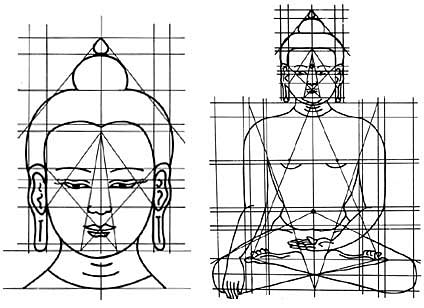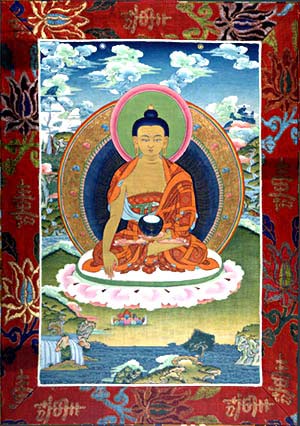
Reviving
Buddha's legacy of vipassana Viji Sundaram
India Abroad News Service, September 06, 2000 13:15 Hrs(IST)
San Francisco: A host of international celebrities swear by it.
But vipassana, an ancient Buddhist technique of mediation, is hardly
everybody's cup of tea.
Imagine willingly signing up for a 10-day meditation course that
requires you to abstain from reading, writing, smoking, drinking,
films, music. Additionally, you are allowed only vegetarian meals
and are required to meditate for 10 hours each day.
"This technique will generate love and compassion,"
observed S.N. Goenka, a world- renowned Indian teacher of the
technique, that forms the core of the Buddha's teachings. "Your
capacity for work increases, your mind becomes healthy."
A Sanskrit term meaning "seeing or experiencing things as
they really are," vipassana, Goenka said, is simply a method of
observing the "play of the mind and allowing it to change its
thought patterns." For example, if you observe an angry thought
long enough, the intensity of the anger diminishes and eventually,
that emotion disappears altogether, he said.
"Even hard core criminals have changed their thought
patterns by observing their minds," he told the
California-based newspaper India-West. "They start experiencing
peace."
The 76-year-old Goenka, who was greeted with repeated standing
ovations at the Millennium World Peace Summit of Religious and
Spiritual Leaders at the United Nations last month, guarantees that
vipassana can help a person overcome "unwholesome" thought
patterns.
Continued practice helps one to rise above anger and hatred, envy
and greed, he said adding that eventually, a practitioner can use it
to attain moksha, like the Buddha did.
Goenka turned to vipassana in 1955 at age 31, when he was a
prosperous industrialist in Myanmar and desperately looking for
something that would cure him of the chronic migraines he suffered.
He was introduced to the technique by the well-known Burmese
vipassana teacher, Sayagyi U Ba Khin.
Over the next 14 years, Goenka trained under Ba Khin. Within
weeks, his headaches disappeared. "I understood that it was my
ego that generated tension, which in turned caused my
headaches," Goenka said, noting, vipassana is "a very
scientific technique."
In 1969, Goenka handed over his business to his sons and moved to
India.
Only 14 people attended his first course, and many of them were
his relatives. Today, vipassana courses are offered in many parts of
the world. The entire course is free, including the three vegetarian
meals served each day.
"How can you charge for such a high spiritual
teaching?" Goenka asked. Nevertheless, the majority of
participants donate something at the end of the course.
To date, Goenka has trained about 600 people from different
religions. In India, Goenka said, tens of thousands of prisoners
have adopted the technique following the 10-day course he conducted
at the Tihar jail in 1995. About 1,000 participants signed up for
that course and today the prison houses a meditation center.
"Followers of every religion are coming to the course,"
Goenka said. "It is so secular. It's simply the art of
living." As you probably know, there are various different
interpretations of what YOGA is but, fundamentally, the definitions
quite the same. Basically, there are eight (asthanga)
"stages" or progressive series of steps, in YOGA:
1. YAMA (restraint) - Ahimsa, Satya, Asteya (non-stealing),
Brhamacharya (moderation) and Aparigraha (non-possesiveness)
2. NIYAMA: (personal observances): Shauchja
(purity/cleanliness), Santosh (contentment), Tapas(austerity),
Svadhyaya (self-study of sacred texts) and Pranidhan (living with
an awareness of divine presence)
3. ASANA* (physical postures)
4. PRANAYAM* (regulation of breath)
5. PRATYAHAR ((discipline of the senses)
6. DHARANA (concentration - focussing)
7. DHYANA* (meditation)
8. SAMADHI (superconsciousness through contemplation)
(of these eight elements/limbs, five are "exterior"
methods concerned primarily with the BODY and PRANA (vital energy)
and three are "interior" methods concerned primarily with
development of the mind.
The four basic YOGA Systems - Raja Yoga (the science of mental
control), Bhakti Yoga (path of Devotion), Karma Yoga (path of
action) and Gyana Yoga (path of Knowledge) - all lead to the same
goal but throguh different methods. What method an individual
selects depends mostly as to what suits their personality and style.
I follow Raja Yoga (which also has the same eight - asthangabs)
but which also is divided into three subdivisions:
1. Mantra Yoga 2. Kundalini Yoga 3. Hatha Yoga
With the risk of generalization, I would say that Kundalini Yoga
is highly popular with the Sikh community (at least in the West),
some of the prominent Gurus and exponents of Kundalini being of Sikh
ancestry.
I practise HATHA Yoga (this is most popular among American,
British and Canadians), which basically has to do with three
elements, PRANAYAMA, ASANA and DHYANA, Dhyana being the most
difficult.
============================
Here is lesson one:
How
to Realize God Lesson 1 - Self Realization is the Goal
Never have there been so many people living on the planet
wondering, "What is the real goal, the final purpose of
life?" However, man is blinded by his ignorance and his concern
with the externalities of the world. He is caught, enthralled, bound
by karma. The ultimate realizations available are beyond his
understanding and remain to him obscure, even intellectually. Man's
ultimate quest, the final evolutionary frontier, is within man
himself. It is the Truth spoken by Vedic rishis as the Self within
man, attainable through control of the mind and purification. It is
karma that keeps us from knowing of and reaching life's final goal,
yet it is wrong to even call it a goal. It is what is, known by the
knower to have always existed. It is not a matter of becoming the
Self, but of realizing that you never were not the Self.
And what is that Self? It is Parashiva. It is God. It is That
which is beyond the mind, beyond thought, feeling and emotion,
beyond time, form and space. That is what all men are seeking,
looking for, longing for. When karma is controlled through yoga and
dharma well performed, and the energies are transmuted to their
ultimate state, the Vedic Truth of life discovered by the rishis so
long ago becomes obvious. That goal is to realize God Siva in His
absolute or transcendent state, which when realized is your own
ultimate state--timeless, formless, spaceless Truth. That Truth lies
beyond the thinking mind, beyond the feeling nature, beyond action
or any movement of the vrittis, the waves of the mind. Being,
seeing, this Truth then gives the correct perspective, brings the
external realities into perspective. They then are seen as truly
unrealities, yet not discarded as such. This intimate experience
must be experienced while in the physical body. One comes back and
back again into flesh simply to realize Parashiva. Nothing more.
Yet, the Self, or Parashiva, is an experience only after it has been
experienced. Yet, it is not an experience at all, but the only
possible nonexperience, which registers in its aftermath upon the
mind of man. Prior to that, it is a goal. After realization, one
thing is lost, the desire for the Self.

Back to top
|